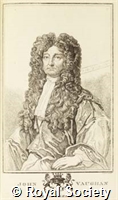| Authorised form of name | Vaughan; John (1639 - 1713); 3rd Earl of Carbery; politician and colonial governor |
| Dates | 1639 - 1713 |
| Nationality | British |
| Date of birth | 18 July 1639 |
| Place of death | Chelsea, Middlesex, England, United Kingdom, Europe |
| Date of death | 16 January 1713 |
| DatesAndPlaces | Baptism:
St Dunstan's in the West, London, England, Europe (18 July 1639)
Burial:
St John the Baptist's chapel, Westminster Abbey, London, England, United Kingdom, Europe (28 January 1713) |
| Occupation | Politician; colonial governor |
| Research field | Mathematics |
| Activity | Education:
Educated at home as a pupil of Jeremy Taylor DD and William Wyatt; Christ Church, Oxford (matriculated 1656); Inner Temple (admitted 1658)
Career:
Whig politician and supporter of Charles II; Commissioner for Militia, Carmarthenshire (1660); Deputy Lieutenant of Carmarthenshire (1660-1687?), and for South Wales (1685-1687?); Commissioner for Assessment for Carmarthenshire (1660-1680), and for Carmarthen (1663-1680); Gentleman of the Privy Chamber (1661-1674?); Member of the Council in the Marches of Wales (1661-1689); MP for Carmarthen (1661-1679); in Parliament, he defended Charles II's interests; aided in the impeachment of former Lord Chancellor the Earl of Clarendon (1667);MP for Carmarthenshire (1679-1681, 1685-1687), Colonel of a regiment of foot (1673-1674); Governor of Jamaica (1675-1678); charged with the supression of piracy, making piracy a capital offence (1677); facilitated the Royal African Company's slave trading into Jamaica; accused of selling his servants into slavery; friend and patron of John Dryden (FRS 1663); Lord of the Admiralty (1683-1684, 1689-1690); Governor of Milford Haven (1686-death); Custos Rotulorum for Carmarthenshire and Cardiganshire (1686-death); Vice-Admiral of South Wales (1689-death); built Gough House, Chelsea (c.1704).
Honours:
KB 1661
Memberships:
Kit-Cat Club |
| Membership category | Fellow |
| Date of election | 21/01/1685 |
| Age at election | 45 |
| RSActivity | Royal Society roles:
PRS 1686-1689; Council 1685, 1689 |
| Other Royal Society activity | Whilst in Jamaica (1675-1678), Vaughan corresponded with Henry Oldenburg (FRS 1663), Secretary of the Royal Society, and sent samples of production |
| Relationships | Parents: Richard Vaughan, 2nd Earl of Carbery, and Frances Altham
Married: 1) Mary Brown; 2) Anne Savile
Children: Anne Powlett
Additional relatives: father-in-law George Savile, 1st Marquess of Halifax (FRS 1675) |
| OtherInfo | Not much is known about his interest in mathematics and in what way or whether he was actively involved in the Royal Society's scientific pursuits. He was close to playwright John Dryden (FRS 1663) and was a supporter and dedicatee of some of his works. Vaughan remained part of the whig establishment, which was important to his membership of the so-called Kit-Cat Club.
In his capacity as Governor of Jamaica Vaughan was a facilitator of The Royal Adventurers into Africa, later Royal African Company (RAC). The RAC was a British trading company established by Royal Charter in 1660 which enslaved and sold African people. The company was chartered by Charles II, the founding royal Patron of the Royal Society, which was also chartered in 1660. The RAC was made up of and funded by members of the Stuart royal family and London merchants many of whom were, or went on to become, Fellows of the Royal Society. The Royal Society itself held shares in the company from 1682 until 1699. The RAC held a monopoly on English trade on the west coast of Africa. The original interest of the company was gold and natural resources. The Company's second charter in 1663 mentions trade in enslaved people, who were mainly transported to British owned estates in the West Indies and America. The Jesus College Cambridge Legacy of Slavery Working Party has stated that the RAC was responsible for selling more Africans into slavery in America than any other institution in the history of the Atlantic slave trade, and that they ran a brutal regime with the full knowledge of their investors. The company became insolvent in 1708, it survived until 1752 when its assets were transferred to the new African Company of Merchants, which lasted until 1821. |
| Related images | Discover a selection of related images in our picture library |
| Image | 
|
| Source | Sources:
Bulloch's Roll; ODNB; GEC; Hunter; Foster; Henning
References:
Anon., 'The history and state of Jamaica under Lord Vaughan', (manuscript, c.1678) National Library of Jamaica, available via the World Digital Library (Library of Congress/UNESCO, 2009-) https://www.wdl.org/en/item/7781/
Frank Cundall, 'The governors of Jamaica in the seventeenth century' (London, 1936)
Mark Govier, 'The Royal Society, Slavery and the Island of Jamaica: 1660-1700' in NR 1999 v.53 pp.203-217, plate.
Notes:
Vaughan was first elected on 20 March 1661, prior to the Society receiving its Royal Charter, and was not officially re-elected FRS of the incorporated Royal Society until the date stated above (21 January 1685). Vaughan is therefore not considered an original Fellow of the Royal Society, a classification reserved for those named in the 1663 charter or elected within the subsequent two months, the period allowed in the charter for the declaration of Fellows. Elections such as Vaughan's, predating this, were no longer recognised. The date of any subsequent re-election is given in this database as the official election date. |
| Virtual International Authority File | http://viaf.org/viaf/296351773 |
| Code | NA8022 |